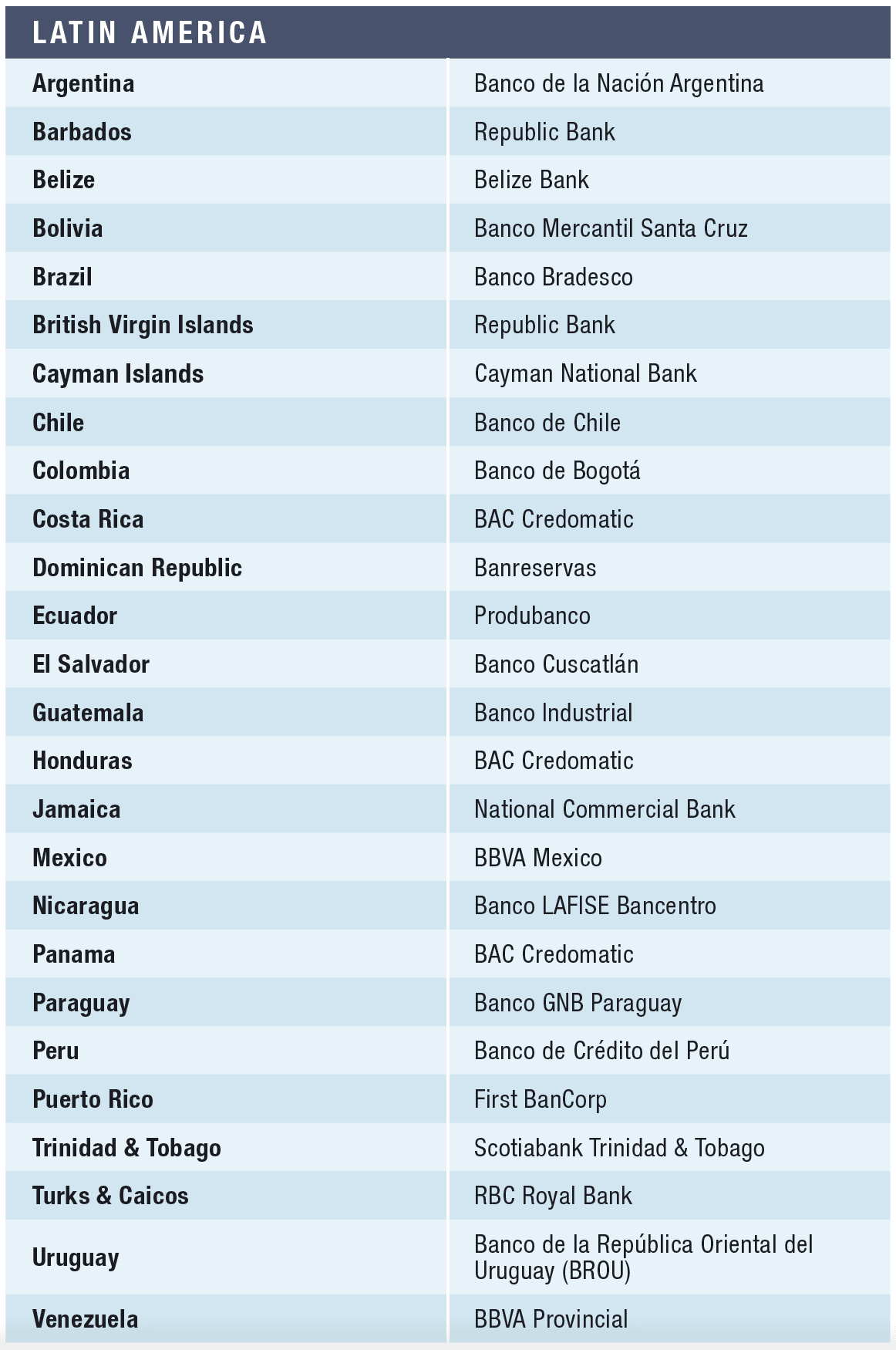Latin America’s Best Banks focused on stabilizing their economies.

As the Covid-19 pandemic spread over Latin America without mercy, the local banks stepped up to serve critical roles in helping their nations cope with the two crises: the pandemic and the consequent eco nomic collapse. Banks on the ground first leaped to adopt measures to protect employees and customers from contagion and to upgrade digital resources to meet the increased demand for contactless banking.
In evaluating candidates for Global Finance’s 2021 World’s Best Banks in Latin America, a major set of criteria revolve around how these institutions maintained their own financial health. A second set considers how well they provided their individual clients with the means to survive, perhaps even thrive, through new waves of contamination, low vaccination and little GDP recovery.
With Brazilian coronavirus variants gaining force and crossing borders, the region may be at risk of a repeat in 2021. The finance sector, no less than health care, is preparing for this possibility while hoping for a sunnier outcome.
Regional Leader
Itaú Unibanco, Brazil’s largest bank, takes our 2021 Latin America regional award. Itaú managed well the pandemic-driven increase in default risk, opening $37 billion worth of credit, largely to corporates and small and midsize enterprises (SMEs); offering debt payment deferrals and extensions; and investing $14.5 million to follow safety protocols in its 3,158 branches. The bank’s commitment to environmental, social and governance (ESG) principles was underlined by its investments in renewable energy projects and its launch, with Bradesco and Santander, of the Amazon Plan to boost sustainable development of the tropical forest.
Recognized as a Latin American leader in deploying technology, in 2020 the bank upgraded its digital infrastructure, migrated to Amazon’s cloud and directly invested in Quanto, a Brazilian open-banking fintech platform for retailers. The bank promotes development of startups through its innovation hub Cubo Itaú. Despite Brazil’s economic disaster, Itaú Unibanco was able to increase assets by more than 21%, to a total of $384 billion, and maintain its domestic Aa1 rating from Moody’s Investors Service.
Banco Bradesco, another top Brazilian bank, takes Global Finance’s top honor at home. After nearly eight decades in operation, Bradesco manages $301.8 billion in assets (18% above 2019) and holds a 12% market share. The bank has just 2.2% nonperforming loans (NPLs) and bolstered reserves by $2.1 billion.
Bradesco made two bold acquisitions in 2020 that should turbocharge its wealth management: JPMorgan Chase’s Brazil operations and BAC Florida Bank. It is a leader in its commitment to sustainable goals, with emissions reduction and the Amazon Plan as centerpieces; and in social programs, through the Bradesco Foundation. Bradesco’s insurance arm supported a private initiative to construct a temporary field hospital in Rio de Janeiro to treat Covid-19 patients last year.
As the pandemic spread, Bradesco introduced digital tools to facilitate client transactions—from renegotiation of debts to major investments. Tools such as artificial intelligence (AI) and digital wallets helped push total transactions up 9%.
BBVA Mexico similarly reinforced its technological tools and ESG commitment in Mexico while helping clients through a difficult year, taking our award as the Best Bank in Mexico. Holding nearly 24% of the total deposits in the country, this bank increased assets by 18% last year to $116.8 billion; and the bank kept its return on equity (ROE) at 22.3% while limiting NPLs to 2%. BBVA Mexico offered key support through the pandemic: restructuring debt, postponing payments, opening new credit lines and more.
Covid-19 made technology improvements a necessity for serving its 21 million clients, who were able to make contactless payments on their cellphones thanks to the bank’s adoption of near-field communications technology last year. More than half of BBVA Mexico’s customers are digital-only.
Southeast Standouts
In the Southern Cone, two state banks made a big difference in mitigating the crisis. Banco de la Nacion Argentina (BNA) was the government’s main tool to support SMEs, spread financial help to the most vulnerable and deliver wages to a vast number of workers. A major bank by assets and clients in Argentina, BNA maintained key indicators of financial health, ESG commitment and digital investment.
The Banco de la Republica Oriental del Uruguay (BROU) followed the same path as BNA and was chosen as the best Uruguayan bank. Responsible for 43% of the banks’ assets in this country and a huge partner for trade companies, BROU had a good financial performance in 2020. It implemented a new digital platform and granted automatic extension of loan payments for companies with less than $200,000 in debts, among other measures.
Banco GNB Paraguay is the country winner for its performance last year. This January, after gaining the approval of regulators, it completed the bold acquisition of BBVA Paraguay for $251.3 million. The institution is expected to become the country’s largest bank in deposits and the second in terms of assets, with about $3.3 billion in 2021.
West Coast
In the Andes, Banco de Chile, the Colombian Banco de Bogota, Banco de Credito del Peru, Ecuador’s Produbanco and the Bolivian Banco Mercantil Santa Cruz are the clear winners in their respective countries. All of them took benefits of their previous digitalization programs, which were accelerated in 2020; embraced the mission to assist their clients with financial difficulties; and improved their social role. They also reinforced their efforts to support the environment and ESG goals.
Banco de Chile, founded over 120 years ago, an institution responsible for managing $58.9 billion in assets and serving 2.2 million clients, registered reasonable ROE (13%), a high efficiency ratio (45.5%) and a low level of NPLs (0.97%) in 2020. Global Finance’s 2021 Best Bank in Chile was also able to preserve its A1 asset quality measured by Moody’s. To improve its electronic connection with clients during the pandemic, it launched new applications, renewed its corporate website and created a 100% digital account. Banco de Chile was responsible for $2.6 billion in transfers from the government to small companies and created its own program to help this segment, besides its actions to assist vulnerable families.
During a devastating year, the 150-year-old Banco de Bogota was able to soften financial obligations for most of its 19 million clients; but it also took care of its employees’ “new normal” with a program of psychological and other support. The bank made several digital improvements so clients could access relief measures through apps and social media. It built an AI advisory and created a medical phone line for its customers. Despite conditions, Banco de Bogota launched a new educational program. It also kept its environmental goals, such as support for a reforestation project in the Amazon region, issuance of an $83 million green bond and creation of a credit line for sustainable projects.
Also well over a century old, the Banco de Credito del Peru reached 4.3 million digital clients in 2020, composing more than half its total customers. The bank invested mainly in cybersecurity and a new innovation center focused on financial solutions. In a country hit hard by Covid-19, the bank donated $24 million to help struggling Peruvians and more than $9.3 million for educational programs.
In Bolivia, Banco Mercantil Santa Cruz also greatly increased its digital accounts–to 30% of the total–and more than 90% of clients’ transactions were concluded using electronic means, particularly through its new 24/7 bank platform. It was a key partner in disseminating government-backed financial help to SMEs.
To mitigate economic damage, Ecuadorian Produbanco focused on small companies, granting $399 million in new loans for those from the productive sectors, and became one of the country’s largest contributors to the struggle against poverty and violence. Its 1.1 million clients enjoyed the bank’s massive investment in digital tools, which include a web network for health emergencies. The bank initiated a business center for teenagers and supported women’s entrepreneurship through the Cafe Mujer, following health protocols, of course.
BBVA Provincial is the winner in Venezuela. Even in a chaotic political and economic environment, the bank consolidated its position as the main institution by assets ($841 million) and registered a significant ROE (21.3%). A pioneer in open banking in Venezuela, the institution invested last year in instant payment tools and adopted a new chatbot that enables payments via social media.




